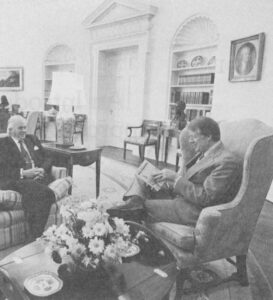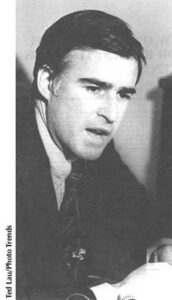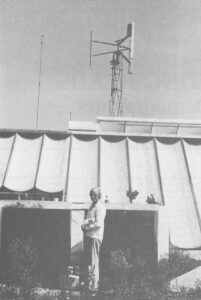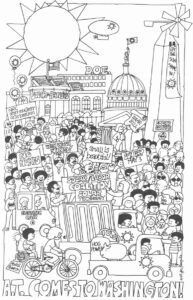I strapped my feet into the bicycle-like pedals and began pumping, turning a chain drive that slowly wound a thin steel cable onto a spool. About 50 feet down the field, a plowing attachment that was bolted to the end of the cable caught in the earth as the line tightened. Guided by another person, the plow inched toward me, wedging a neat furrow about half a foot deep into the sodded soil.
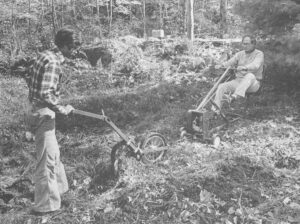 The Mechanical Mule is the device’s trademarked name, and it probably will go on the market this spring. It would be surprising if this pedal-powered plowing device, which is to carry a price tag of $300 or more, became a best seller. In fact, its manufacturer, Rodale Press, is only planning to make a couple hundred of the things to begin with. Yet Rodale has been immensely successful in other unconventional enterprises, including Organic Gardening magazine; the company has spent more than a year developing the Mechanical Mule; so perhaps they’re on to something. The possibility inspired me to try out a pre-production prototype the other day, in a friend’s garden in upstate New York.
The Mechanical Mule is the device’s trademarked name, and it probably will go on the market this spring. It would be surprising if this pedal-powered plowing device, which is to carry a price tag of $300 or more, became a best seller. In fact, its manufacturer, Rodale Press, is only planning to make a couple hundred of the things to begin with. Yet Rodale has been immensely successful in other unconventional enterprises, including Organic Gardening magazine; the company has spent more than a year developing the Mechanical Mule; so perhaps they’re on to something. The possibility inspired me to try out a pre-production prototype the other day, in a friend’s garden in upstate New York.
Should the Mechanical Mule prove to be of at least symbolic significance, it will be because it epitomizes an emerging counter technology, variously labeled soft technology, appropriate technology or simply AT. Envisioned as a fundamental alternative to much of modem industrial technology, AT devices and processes are prized by their advocates for being environmentally innocuous, small, more “human” scaled, and independent of centralized controls or energy sources. They also are invariably what economists and technologists call relatively “labor-intensive. “
That’s a somewhat abstract way of saying that human attentions and exertions are a major ingredient in their operation, as compared to inanimate energy sources and powered machinery. As such, AT styles are bucking a strong historical tide: technology in general has become less and less labor-intensive, more and more capital-and energy-intensive. For centuries we have been substituting machines for men and women.
For this reason, a device to harness human leg power might easily be dismissed as a quirky anachronism; much of AT thinking in general tends to be so regarded by the unconverted. Yet quite apart from AT theologies, the evidence of late has been accumulating to prove that greater labor intensity-perhaps the most controversial and most historically defiant characteristic of appropriate technology is actually being dictated by raw economic forces. The Mechanical Mule may not be anachronism so much as harbinger of technological styles to come.
The economics are clearest and the movement toward greater labor-intensity strongest in developing countries. Energy and capital resources are scarcest in these lands, and they enjoy, or suffer, abundances of labor. The International Labour Organization has estimated that the amount of unemployment in developing countries adds up to more than the entire population of the U.S. Thus, by conventional economic reasoning, it makes sense to use more labor and less energy and machinery. As the publication World Development notes in an issue analyzing various possible ways of manufacturing a number of different products, “the least cost technology is … sometimes nearer the labor-intensive than the capital-intensive end of the spectrum.” Partly because of such reckonings, a good deal of rethinking about technological advice and aid to developing countries has been going on in recent years, and it is expected that considerations of the role of labor-intensive appropriate technology approaches will be one of the storm-centers at the United Nations Conference on Science and Technology for Development, to be held next summer in Vienna.
Since the 1973 Arab oil boycott and the quadrupling of world petroleum prices, resource constraints on technology have come abruptly home to developed countries as well. Energy costs, of course, have soared-reversing a constant downward course in such costs that dates from the dawn of the Industrial Revolution-and so; too, to a lesser degree have capital costs. Labor costs have grown less rapidly and high unemployment has persisted or emerged in developed countries as a major social and political concern. Thus, a prospect that might a few years ago have been regarded as a virtual contradiction in terms in modem industrial countries can be put forward quite matter-of-factly for the U.S., and was a while ago, from such solid and analytically unventuresome ranks as agricultural economists. In a coauthored paper, two such economists, R. Delworth Gardner and Rulen D. Pope of the University of California, noted that the price of farm machinery has been climbing proportionately more in recent years than farm wages. “On the basis of this evidence,” they wrote, “one might speculate that future innovations might be…machinery saving.”
Machinery-saving innovation? It still has an odd ring, but machinery saving is the other side of the labor-intensity coin. And if regular economists are somewhat cautious about foreseeing such an irregular shift, some economic analysts outside their ranks are not. Hazel Henderson, author of Creating Alternative Futures, which is subtitled “The End of Economics,” sees a very definite end to an economic pattern that we have all but taken for granted. “People are now plentiful and resources are scarce,” she writes, “and as a consequence the capital labor ratio has now shifted back toward increased labor in varying degrees all over the planet.”
The matter of labor-intensity, and the contention that technology may be becoming more rather than less labor-intensive, is not limited to discussions among economists or their detractors, for that matter. Such concerns are at the center of what appears to be the major technological debate of our time-ever what sort of energy-producing technology-“soft” or “hard”-should be pursued as petroleum prices grow ever larger.
Part of the debate focuses on matters of occupational and environmental safety, part on questions about centralized versus decentralized technology. But increasingly, the political heart of the debate is about labor, jobs.
“Hard” energy technology is defined in part by its capital-intensity. It takes a lot of equipment to generate power by hard methods. Large coal-and nuclear-fueled electricity plants are considered the hardest of hard technology methods. The argument of those in favor of expanding such technology has been focused in part on jobs; the argument was summarized, at an atomic industry meeting two years ago by Arnold Safer, a vice president of the Irving Trust Company. “It will take an increasing amount of energy to sustain the same number of jobs in the economy,” he said, “if these jobs are to generate a higher level of real income to working men and women.” This argument subdivides into three main parts: that more nuclear and coal power are essential if we are to increase the overall energy supply, that more energy is needed to fuel a growing economy and that a growing economy is needed to expand tile number of jobs. The NAACP this year, to the discomfort of “soft” energy forces, endorsed this viewpoint and the higher echelons of organized labor as well as much of the business community subscribe to it. It became the contentious stuff of partisan politics in California’s gubernatorial race, where foes of Governor Jerry Brown, who has associated himself with a statewide moratorium on nuclear plant construction, sought to brand this stand as recklessly endangering California’s economy and job supply.
Soft energy forces favor conservation and solar alternatives. Until recently they tended to be defensive about job-oriented assaults. But in the last year, they have marshaled analyses and economic studies of their own that lay claim to the job-creation banner; soft energy approaches, they now say, are the more plentiful provider of jobs.
A group called Environmentalists for Full Employment has spearheaded the counterattack. Last year, they issued a pamphlet entitled Jobs and Energy. In it, the group asserted and cited evidence that economic growth did not depend on energy expansion and that such expansion might, in any case, decrease the number of jobs. (Amory Lovins, one of the foremost advocates of an energy “soft path,” has calculated that new centralized energy production can actually lead to a net loss of jobs.) The nation’s major energy-producing and energy-consuming industries, said the pamphlet, consumed one-third of the energy supply, yet only accounted for one-tenth of the jobs. “Since World War II, new jobs have been created overwhelmingly in the merchandising and service sectors of the economy … These jobs have required relatively low amounts of energy, capital and resources…”
The theme was enlarged upon by several witnesses earlier this year at congressional hearings titled “Creating Jobs Through Energy Policy ” before the Joint Economic Committee’s subcommittee on energy headed by Senator Edward Kennedy. Among the witnesses was James Benson of the Council of Economic Priorities. (He also heads a group that publishes an energetically populist periodical called People And Energy.) Benson is completing a cost-benefit study of nuclear vs. alternative energy prospects in Long Island. The study finds, he said, that two and a half times as many jobs would be created directly by conservation and solar installations and maintenance as would by ever-greater outlays for nuclear construction and upkeep. What’s more, Benson said, the study indicates that many billions would be saved in consumer energy costs, money that would be spent for other, more labor-intensive job producing services and products.
Kennedy himself apparently was impressed by such testimony-and has been scornful of the fact that Labor Department and Energy Department witnesses had little hard analysis to offer on the relations between different energy technologies and jobs. In September, he showed up at an anti-nuclear gathering in Washington and while carefully avoiding any attack on nuclear energy, declared that there was “over-powering evidence … that shows the area of conservation [to offer] clearly the most important resources in this country, both in terms of what actually can be saved and in terms of… the implications [for] jobs and job skills… ” A few weeks ago, Kennedy addressed the New England Energy Congress and stressed the importance of linking energy policy to jobs, and concluded that “conservation is the best job creator of all, outperforming all other energy measures by a margin of 3 to 1, considering both direct and indirect employment.
“This smacks a little of a contest to see who can be more inefficient,” said Carl Goldstein, a spokesman for the Atomic Industrial Forum, a nuclear promotion group, when I noted that soft energy forces seemed to be building a case that they could create more jobs. “I could solve the nation’s unemployment problem overnight by putting every jobless man to work carrying coal from Appalachia to New York in bushel baskets, but I don’t think that this would necessarily make coal the energy source of choice. “
A particularly telling exchange reflecting the widely divergent perspectives on technology and labor took place during Kennedy’s energy subcommittee hearings. The protagonists were Maudine R. Cooper, deputy director of the Washington Bureau of the National Urban League, and Senator James McClure of Idaho, a congressional friend of nuclear energy and a member of the subcommittee.
Coopen… “If you were to examine, for example, a nuclear facility, you walk in and see absolutely no people. You see computers … What I see us doing is growing but using less and less manpower. We are becoming a technological society. What that means for our constituency is no jobs.
McClure: Does that mean that? That may be the basic question we have to answer. But it may mean they don’t have any jobs where the energy is produced but there are jobs where it is consumed.
Cooper: That is also questionable. We can go into our manufacturing companies and we will see now assembly lines where there is little or no manpower. I know the argument has been well documented that we are becoming a technological society.
McClure: And you think that is bad?
Cooper: It is bad if it means we will have only machines rather than people.
McClure…If I understand it, you would go back to building the interstate highway by use of pick and shovel and wheelbarrows instead of using tractors?
Cooper: No. I think a balance should be struck between the technologies that are being advanced today and full employment as a national goal… does it make a lot of sense to have us spend $45,000 a year to keep a person incarcerated when we could have given that person a job, cut back a little on technology, 5 or 10 years before he or she was arrested? Does it make sense for us to continue developing high technology when we should be putting those monies into the educational system to keep young, poor kids from dropping out in inordinate numbers? Nobody seems to be looking at this. We look at the cost benefit analysis in terms of direct machine costs rather than the social cost or the long-range social cost.”
The economic arguments almost invariably spill over into more broadly social, even moral terrain. Most advocates of labor-intensive appropriate technology that I’ve met are quite happy to find and recite evidences that resource economics are shifting us away from conventional technology, but they feel that economic analysis itself and public policy based on this analysis has been too narrow all along in weighing the costs and benefits of labor-saving technology. They feel that the social, psychological and environmental costs of much of our technology tend to be ignored because it is hard to put a price tag on them, and that the benefits, in terms of gaining more goods and services for less work are overestimated.
Many advocates of more labor-intensive technology say, for instance, small-scale food production is worthwhile, even if huge-scale farming using $60,000 tractors and immense combine harvesters can provide food much more cheaply in pure market terms. Their calculus includes the ecological tolls of using the powerful chemical fertilizers and pesticides that accompany large-scale mechanized agriculture and the social and spiritual costs of destroying both livelihood and way of life for the millions of farmers and farm workers that the machinery has rendered dispensable.
Does this mean that even something like the pedal-powered plow can make sense these days? Or is it simply a quizzical anachronism, equivalent to the ladies of Versailles playing milkmaid, to use a derisive comparison that Herman Kahn has applied to middle-class shunners of modern technology. I asked James Benson. He said, “All of this gets down to values. We have to sift through values that have been discussed since the time of the Greeks. I mean what’s important to life, what is life all about? It really gets down to that. Imagine living in an ecologically oriented society where people were somewhat self-sufficient through the use of small-scale but technical devices, were raising their own food on either a community or individual basis. What would people living in a society like that think of somebody who spent four hours a day sitting in an easy chair and drinking beer and watching television? The point is the person raising food has a value set that says this is valuable to me because it’s exercise, because I’m raising nutritious food, because I’m helping the environment not be exploited and destroyed by energy-intensive agriculture and also not being taken advantage of by agribusiness, and so on and so forth.”
A more ambivalent, and probably more prevalent, alternative that has at least implicitly faced society, as a whole over recent decades is between grueling manual labor and empty prideless lives on the dole or assembly line. But the point of Benson’s polarization is still apt for an affluent society: do we treasure accomplishments as producers as much as the rewards, in more leisure and cheaper products, of consumption? And for a society that is no longer so affluent in terms of one of the basic currencies, energy, the question may no longer be primarily a philosophical one, but one with major implications for technology and public policy technology for years, perhaps decades to come.
©1978 Wade Greene
WADE GREENE’s Fellowship study is on the Appropriate Technology Movement.


